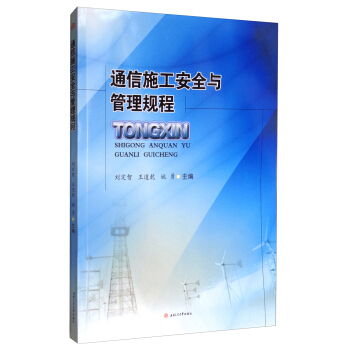

具体描述
内容简介
本书是关于多传感器编队目标跟踪方法的一部专著,是作者们对国内外近30年来该领域研究进展和自身研究成果的总结。全书由6章组成,主要内容有:基础知识概述,编队目标航迹起始方法,复杂背景下集中式多传感器编队目标跟踪方法,集中式多传感器机动编队目标跟踪方法,系统误差下编队目标航迹关联方法,建议与展望。作者简介
王海鹏,博士,海军航空工程学院信息融合研究所综合研究室副主任兼院士秘书、讲师。研究领域为多传感器多目标跟踪、航迹关联、大数据技术等。作为课题组长或技术总师承担国家自然基金、总装预研基金等多项,发表学术论文多项。获山东省优秀科技成果创新奖和海军优秀硕士学位论文奖。目录
第1章 绪 论 11.1 研究背景 1
1.2 国内外研究现状 2
1.2.1 航迹起始 2
1.2.2 航迹维持 3
1.2.3 机动跟踪 3
1.3 多传感器编队目标跟踪技术中有待解决的一些关键问题 4
1.3.1 杂波环境下编队目标航迹起始技术 4
1.3.2 复杂环境下集中式多传感器编队目标跟踪技术 5
1.3.3 集中式多传感器机动编队目标跟踪技术 5
1.3.4 系统误差下编队目标航迹关联技术 6
1.4 本书的主要内容及安排 7
第2章 编队目标航迹起始算法 8
2.1 引言 8
2.2 基于相对位置矢量的编队目标灰色航迹起始算法 8
2.2.1 基于循环阈值模型的编队预分割 10
2.2.2 基于编队中心点的预互联 11
2.2.3 RPV-FTGTI 算法 12
2.2.4 编队内目标航迹的确认 18
2.2.5 编队目标状态矩阵的建立 19
2.2.6 仿真比较与分析 20
2.2.7 讨论 34
2.3 集中式多传感器编队目标灰色航迹起始算法 35
2.3.1 多传感器编队目标航迹起始框架 35
2.3.2 多传感器预互联编队内杂波的剔除 36
2.3.3 多传感器编队内量测合并模型 37
2.3.4 航迹得分模型的建立 38
2.4 基于运动状态的集中式多传感器编队目标航迹起始算法40
多传感器编队目标跟踪
VIII
2.4.1 同状态航迹子编队获取模型 40
2.4.2 多传感器同状态编队关联模型 45
2.4.3 编队内航迹精确关联合并模型 45
2.5 仿真比较与分析 46
2.5.1 仿真环境 47
2.5.2 仿真结果及分析 47
2.6 本章小结 54
第3章 复杂背景下集中式多传感器编队目标跟踪算法 56
3.1 引言 56
3.2 系统描述 56
3.3 云雨杂波和带状干扰剔除模型 57
3.3.1 云雨杂波剔除模型 58
3.3.2 带状干扰剔除模型 60
3.3.3 验证分析 61
3.4 基于模板匹配的集中式多传感器编队目标跟踪算法 63
3.4.1 基于编队整体的预互联 63
3.4.2 模板匹配模型的建立 65
3.4.3 编队内航迹的状态更新 69
3.4.4 讨论 69
3.5 基于形状方位描述符的集中式多传感器编队目标粒子滤波算法 69
3.5.1 编队目标形状矢量的建立 70
3.5.2 相似度模型的建立 72
3.5.3 冗余图像的剔除 74
3.5.4 基于粒子滤波的状态更新 74
3.6 仿真比较与分析 75
3.6.1 仿真环境 75
3.6.2 仿真结果 76
3.6.3 仿真分析 78
3.7 本章小结 79
第4章 集中式多传感器机动编队目标跟踪算法 81
4.1 引言 81
4.2 典型机动编队目标跟踪模型的建立 82
目 录
IX
4.2.1 编队整体机动跟踪模型的建立 82
4.2.2 编队分裂跟踪模型的建立 85
4.2.3 编队合并跟踪模型的建立 87
4.2.4 编队分散跟踪模型的建立 89
4.3 变结构JPDA机动编队目标跟踪算法 91
4.3.1 事件的定义 92
4.3.2 编队确认矩阵的建立 93
4.3.3 编队互联矩阵的建立 93
4.3.4 编队确认矩阵的拆分 95
4.3.5 概率的计算 97
4.3.6 编队内航迹的状态更新 100
4.4 扩展广义S-维分配机动编队目标跟踪算法 101
4.4.1 基本模型的建立 102
4.4.2 编队量测的划分 103
4.4.3 3-维分配问题的构造 106
4.4.4 广义S-维分配问题的构造 107
4.4.5 编队内航迹的状态更新 107
4.5 仿真比较与分析 108
4.5.1 仿真环境 108
4.5.2 仿真结果 110
4.5.3 仿真分析 113
4.6 本章小结 114
第5章 系统误差下编队目标航迹关联算法 116
5.1 引言 116
5.2 系统误差下基于双重模糊拓扑的编队目标航迹关联算法 116
5.2.1 基于循环阈值模型的编队航迹识别 117
5.2.2 第一重模糊拓扑关联模型 118
5.2.3 第二重模糊拓扑关联模型 123
5.3 系统误差下基于误差补偿的编队目标航迹关联算法 125
5.3.1 编队航迹状态识别模型 125
5.3.2 编队航迹系统误差估计模型 127
5.3.3 误差补偿和编队内航迹的精确关联 130
5.3.4 讨论 130
多传感器编队目标跟踪
X
5.4 仿真比较与分析 131
5.4.1 仿真环境 131
5.4.2 仿真结果及分析 132
5.5 本章小结 134
第6章 结论及展望 135
附录A 式(2-17)中阈值参数ε 的推导 140
附录B 式(5-19)的推导 144
参考文献 148
CONTENTS
Chapter 1 Introduction 1
1.1 Background of Research 1
1.2 Internal and Oversea Research Actualities 2
1.2.1 Track Initiation 2
1.2.2 Track Maintenance 3
1.2.3 Maneuvering Tracking 3
1.3 The Key Problem to Be Resolved in Multi-sensor Formation Targets
Tracking Technique 4
1.3.1 Formation Targets Track Initiation Technique with Clutter 4
1.3.2 Centralized Multi-sensor Formation Targets Tracking Technique
with the Complicated Background 5
1.3.3 Centralized Multi-sensor Maneuvering Formation Targets Tracking
Technique 5
1.3.4 Track Correlation Technique of the Formation Targets with
Systematic Errors 6
1.4 Main Content and Arragement of Dissertation 7
Chapter 2 Formation Targets Track Initiation Algorithm 8
2.1 Introduction 8
2.2 Formation Targets Gray Track Initiation Algorithm Based on Relative
Position Vector 8
2.2.1 Preparative Division of the Formation Targets Based on the
Circulatory Threshold Model 10
2.2.2 Preparative Association Based on the Formation Center 11
2.2.3 RPV-FTGTI Algorithm 12
2.2.4 Validation of the Tracks in the Formation 18
2.2.5 Establishment of the Formation Target State Matrix 19
2.2.6 Simulation Comparision and Analysis 20
2.2.7 Discussion 34
2.3 Centralized Multi-sensor Formation Targets Gray Track Initiation
Algorithm 35
2.3.1 Multi-sensor Formation Targets Track Initiation Frame 35
2.3.2 Multi-sensor Clutter Deletion in Preparative Associated
多传感器编队目标跟踪
XII
Formations 36
2.3.3 Multi-sensor Measurement Mergence Model in the Formation 37
2.3.4 Establishment of the Track Score Model 38
2.4 Centralized Multi-sensor Formation Targets Track Initiation Algorithm
Based on Moving State 40
2.4.1 Same-state Track SubFormation Obtainment Model 40
2.4.2 Multi-sensor Same-state Formation Association Model 45
2.4.3 Accurate Association and Mergence Model of the Formation
Tracks 45
2.5 Simulation Comparision and Analysis 46
2.5.1 Simulation Envirenment 47
2.5.2 Simulation Results and Analysis 47
2.6 Summary 54
Chapter 3 Centralized Multi-sensor Formation Targets Tracking Algorithm with the
Complicated Background 56
3.1 Introduction 56
3.2 System Description 56
3.3 Deletion Models of the Cloud-rain Clutter and the Narrow-Band
Interference 57
3.3.1 Cloud-rain Clutter Deletion Model 58
3.3.2 Narrow-Band Interference Deletion Model 60
3.3.3 Validation and Analysis 61
3.4 Centralized Multi-sensor Formation Targets Tracking Algorithm Based on
Template Matching 63
3.4.1 Preparative Association Based on the Whole Formation 63
3.4.2 Establishment of the Template Matching Model 65
3.4.3 State Update of the Tracks in the Formation 69
3.4.4 Discussion 69
3.5 Centralized Multi-sensor Formation Targets Particle Filter Based on Shape
and Azimuth Descriptor 69
3.5.1 Establishment of the Formation Targets Shape Vector 70
3.5.2 Establishment of the Resemble Model 72
3.5.3 Deletion of the Redundant Picture 74
3.5.4 State Update Based on Particle Filter 74
CONTENTS
XIII
3.6 Simulation Comparision and Analysis 75
3.6.1 Simulation Envirenment 75
3.6.2 Simulation Results 76
3.6.3 Simulation Analysis 78
3.7 Summary 79
Chapter 4 Centralized Multi-sensor Maneuvering Formation Targets Tracking
Algorithm 81
4.1 Introduction 81
4.2 Establishment of Typical Maneuvering Formation Targets Tracking
Models 82
4.2.1 Establishment of the Formation Whole Maneuver Tracking
Model 82
4.2.2 Establishment of the Formation Splitting Tracking Model 85
4.2.3 Establishment of the Formation merging Tracking Model 87
4.2.4 Establishment of the Formation dispersing Tracking Model 89
4.3 Maneuvering Formation Targets Tracking Algorithm Based on Different
Structure JPDA Technique 91
4.3.1 Event Definition 92
4.3.2 Establishment of the Formation Validation Matrix 93
4.3.3 Establishment of the Formation Association Matrix 93
4.3.4 Splitting of the Formation Validation Matrix 95
4.3.5 Calculation of the Probability 97
4.3.6 State Update of the Tracks in the Formation 100
4.4 Maneuvering Formation Targets Tracking Algorithm Based on Patulous
Generalized S-D Assignment Technique 101
4.4.1 Establishment of the Basic Model 102
4.4.2 Partition of the Measurements of the Formation Targets 103
4.4.3 Conformation of 3-D Assignment Problem 106
4.4.4 Conformation of Generalized S-D Assignment Problem 107
4.4.5 State Update of the Tracks in the Formation 107
4.5 Simulation Comparision and Analysis 108
4.5.1 Simulation Envirenment 108
4.5.2 Simulation Results 110
4.5.3 Simulation Analysis 113
多传感器编队目标跟踪
XIV
4.6 Summary 114
Chapter 5 Formation Targets Track Correlation Algorithm with Systematic
Errors 116
5.1 Introduction 116
5.2 Formation Targets Track Correlation Algorithm with Systematic Errors
Based on Double Fussy Topology 116
5.2.1 Formation Tracks Identification Based on Circulatory Threshold
Model 117
5.2.2 The First Scale Fussy Topology Model 118
5.2.3 The Second Scale Fussy Topology Model 123
5.3 Formation Targets Track Correlation Algorithm with Systematic Errors
Based on Error Compensation 125
5.3.1 Formation Track State Identification Model 125
5.3.2 Formation Track Systematic Error Estimation Model 127
5.3.3 Error Compensation and Formation Track Accurate
Correlation 130
5.3.4 Discussion 130
5.4 Simulation Comparision and Analysis 131
5.4.1 Simulation Envirenment 131
5.4.2 Simulation Results and Analysis 132
5.5 Summary 134
Chapter 6 Conclusions and Prospects 135
Appendix A Illation of the Threshold Parameter ε in Formula (2-17) 140
Appendix B Illation of Formula (5-19) 144
References 148
前言/序言
多传感器编队目标跟踪技术是现阶段目标跟踪领域的研究重点和难点之一。本书以国家自然科学基金资助项目、山东省自然基金资助项目为背景依托,针对编队目标跟踪领域中的一些关键问题进行了深入研究,提出了多种新的、便于工程应用的多传感器编队目标跟踪算法。
全书共分6章,第1章介绍了多传感器编队目标跟踪的研究背景、国内外研究现状、以及一些有待解决的关键问题。第2章介绍了编队航迹目标起始算法,为解决编队内目标难以正确起始的问题,提出了基于相对位置矢量的编队目标灰色航迹起始算法、集中式多传感器编队目标灰色航迹起始算法和基于运动状态的多传感器编队目标航迹起始算法。第3章介绍了复杂背景下集中式多传感器编队目标跟踪算法,为解决复杂背景下多传感器非机动编队内目标的跟踪问题,首先基于群分割中图像法的思想建立了云雨杂波剔除模型和带状干扰剔除模型,然后基于相邻时刻同一编队内目标真实回波空间结构相对固定的特性,分别提出了基于模板匹配的集中式多传感器编队目标跟踪算法和基于形状方位描述符的集中式多传感器编队目标粒子滤波算法。第4章介绍了集中式多传感器机动编队目标跟踪算法,为解决多传感器探测下无法正确跟踪机动编队内目标的问题,首先建立了整体机动、分裂、合并、分散四种典型机动模式下的编队目标跟踪模型,然后提出了变结构JPDA机动编队目标跟踪算法和扩展广义S-维分配机动编队目标跟踪算法。第5章介绍了系统误差下编队目标航迹关联算法,为解决系统误差下编队内目标的跟踪问题,提出了基于双重模糊拓扑的编队目标航迹关联算法和基于误差补偿的编队目标航迹关联算法。第6章回顾和总结本书的研究成果,并对某些问题提出进一步的研究建议。
本书由烟台海军航空工程学院王海鹏、编著。多传感器编队目标跟踪技术是一个信息融合领域的一个研究热点,本书不可能对这个领域的发展做出统揽无余的介绍。为此,我们在本书最后一章对一些新的研究思路进行了展望,供读者进一步研究参考。同时,由于编著者水平有限,书中难免还存在一些缺点和错误,殷切希望广大读者批评指正。
用户评价
这本书为我打开了全新的视野。作者在阐述“多目标跟踪”那一章时,仿佛一位经验丰富的指挥官,将复杂的战场态势娓娓道来。他详细介绍了多种多目标跟踪的经典算法,如JPDA、MHT等,并深刻分析了它们在处理目标数量变化、目标交汇、虚警漏警等复杂情况时的优势与劣势。我尤其被书中关于“目标关联”策略的探讨所吸引。作者不仅列举了多种常用的关联方法,还结合实际场景,分析了不同方法的适用性和局限性。他对于如何平衡跟踪的实时性和准确性,以及如何在有限的计算资源下实现高效的多目标跟踪,提出了许多独到的见解。读完这一章,我对于如何构建一个能够应对复杂动态环境的多目标跟踪系统,有了更清晰的认识,并且对未来无人系统在协同作战、智能监控等领域的应用充满期待。
评分这本书的深度和广度都令人印象深刻。作者在技术细节的阐述上毫不含糊,但又善于将复杂的概念层层剥离,使其易于理解。我尤其赞赏作者在介绍“非线性滤波”那一章节时,那种循序渐进的讲解方式。从经典的卡尔曼滤波,到扩展卡尔曼滤波,再到无迹卡尔曼滤波和粒子滤波,每一个算法的推导过程都详尽而严谨,并且清晰地指出了它们各自的优缺点以及适用的场景。更重要的是,作者并没有止步于理论公式的堆砌,而是通过对不同滤波方法的仿真结果进行对比分析,直观地展示了它们在实际目标跟踪任务中的表现差异。这种深入浅出的讲解方式,对于我这样想要深入理解算法原理的读者来说,无疑是莫大的福音。它不仅满足了我对技术细节的渴求,更帮助我建立了对不同跟踪算法的深刻认知,为我今后的研究打下了坚实的基础。
评分这本书真是让人眼前一亮!当我翻开它,就立刻被深深吸引住了。作者的叙事风格非常生动,仿佛一位经验丰富的老兵在娓娓道来,将那些原本可能枯燥的技术细节描绘得栩栩如生。我特别喜欢其中对“协同感知”那一章的解读,它没有停留在理论层面,而是通过大量生动的案例,展示了多传感器融合是如何在复杂环境下实现更精确、更鲁棒的目标跟踪的。书中的图示也非常清晰,直观地解释了各种算法的原理和工作流程。我尤其欣赏作者在讲解过程中,时不时地穿插一些实际应用场景的分析,比如在无人机编队协同侦察、自主驾驶车辆避障等方面的应用,这让我在学习理论知识的同时,也能深刻理解其背后蕴含的巨大潜力和价值。读这本书的过程,更像是一次思维的冒险,不断有新的启发和思考涌现。它不仅仅是一本技术书籍,更是一扇通往未来智能系统的大门,让我对这个领域充满了无限的遐想和期待。
评分这本书的叙述风格独具匠心,既有学术的严谨,又不失文学的温度。作者在描绘“目标运动模型”时,就像一位细腻的画家,用文字勾勒出目标的各种运动轨迹。他深入浅出地介绍了常用于目标跟踪的各种模型,如匀速模型、匀加速模型、转弯模型等,并重点分析了如何根据实际情况选择最合适的模型。我特别喜欢作者在解释“模型不确定性”时所做的比喻,它让那些抽象的概念变得生动易懂。此外,书中关于“目标状态估计的不确定性分析”的章节,也给我留下了深刻的印象。作者并没有回避跟踪过程中固有的不确定性,而是积极地探讨如何量化和管理这种不确定性,例如通过协方差矩阵的分析来评估估计的精度。这种坦诚和深入的探讨,让我对目标跟踪技术的局限性有了更清晰的认识,也激发了我进一步探索更优越估计方法的思考。
评分这是一本充满实践智慧的书。作者仿佛是一位资深的工程师,将多年的实战经验浓缩其中。在阅读“传感器网络部署与管理”的章节时,我感受到了强烈的现场感。作者详细阐述了如何根据实际任务需求,合理选择传感器类型、优化传感器布局,以及如何处理传感器间的时空同步问题。书中列举的各种实际部署案例,如在野外复杂地形中如何布设声学传感器阵列,或者在城市环境中如何协调摄像头和雷达进行目标跟踪,都充满了真知灼见。我尤其受益于作者关于“多传感器数据质量评估与异常处理”的论述,这部分内容往往是许多理论书籍所忽视的,但却是实际应用中至关重要的一环。书中提供的多种实用策略和技巧,能够帮助我们在面对传感器故障、噪声干扰等问题时,找到有效的解决方案,从而确保跟踪系统的鲁棒性和可靠性。
相关图书
本站所有内容均为互联网搜索引擎提供的公开搜索信息,本站不存储任何数据与内容,任何内容与数据均与本站无关,如有需要请联系相关搜索引擎包括但不限于百度,google,bing,sogou 等,本站所有链接都为正版商品购买链接。
© 2026 windowsfront.com All Rights Reserved. 静流书站 版权所有


![电子应用系统设计 [Design of Electronic Application System] pdf epub mobi 电子书 下载](https://pic.windowsfront.com/12146087/598188e8N45c3fafa.jpg)
![基于数字样机的维修性技术与方法/数字制造科学与技术前沿研究丛书 [Methods And Technologies For Virtual Prototype Based Maintainability Engineering] pdf epub mobi 电子书 下载](https://pic.windowsfront.com/12146530/58cbc54bN12642a07.jpg)
















